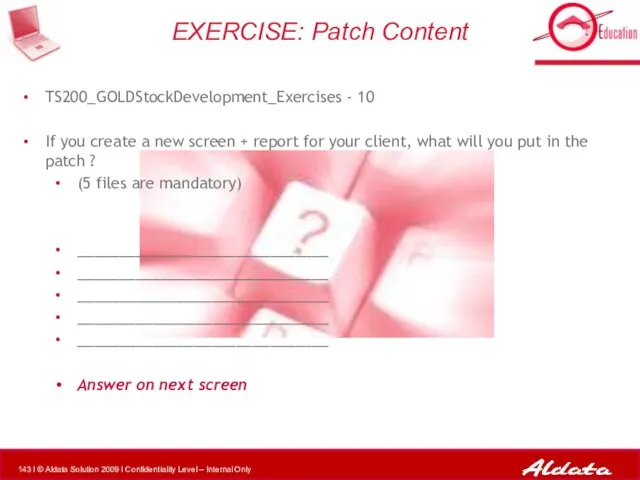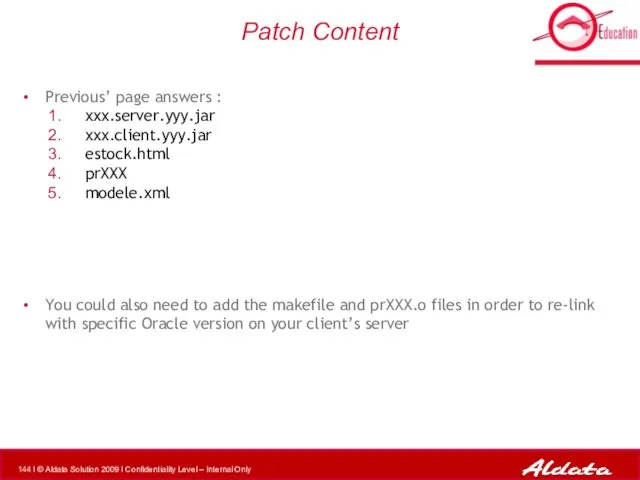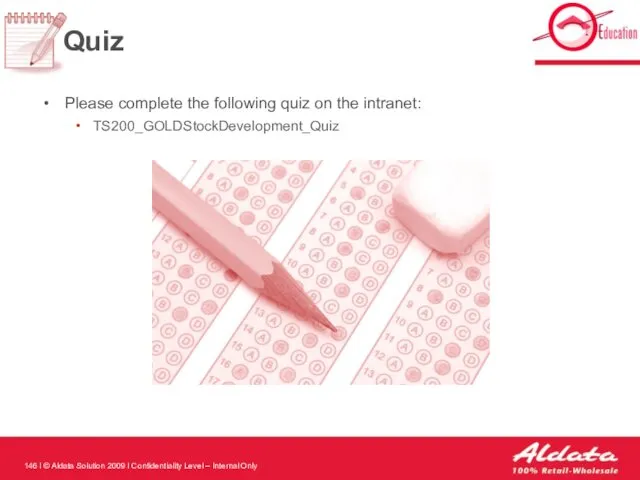Содержание
- 2. Group Introduction Trainee Name Trainee Name Trainee Name Trainee Name Trainee Name Trainee Name Trainee Name
- 3. Objectives & Benefits After this training : You will understand : The G.O.L.D. architecture How G.O.L.D.
- 4. Pre-Requisites JAVA PRO*C Knowledge Software ADER (mandatory) Report Designer (mandatory) Eclipse (recommended) Crimson /Notepad++ / Ultra
- 5. General Overview 1 2 3 Table of content 4 5 Global Architecture and Application Structure G.O.L.D.
- 6. General Overview : About G.O.L.D 1 2 3 Table of content 4 5 Global Architecture and
- 7. G.O.L.D. solution map : a reminder
- 8. G.O.L.D. Stock G.O.L.D. Stock is a set designed to control the following functions: the basic data
- 9. Interfacing G.O.L.D. Definition : G.O.L.D. can be interfaced with third party systems from which it can
- 10. General Overview : Development tools 1 2 3 Table of content 4 5 Global Architecture and
- 11. ADER ADER : is a small application developed by the Aldata R&D team is used to
- 12. Eclipse Java integrated development environment
- 13. Graphic Framework Documentation Graphic Framework Documentation (JavaDoc UI) is delivered in ZIP format contains the rules
- 14. Report Designer Report Designer : is a small application developed by the Aldata R&D team is
- 15. Setup server and database connection Install development tools (c:\sdt\) ADER REPORT DESIGNER Graphic Framework Documentation (JavaDoc
- 16. General Overview 1 2 3 Table of content 4 5 Global Architecture and Application Structure G.O.L.D.
- 17. A 3 tiers architecture G.O.L.D. is a 3 tiers architecture solution where : The G.O.L.D. clients
- 18. G.O.L.D. Modules managed eStock eRetail Adm Pda
- 19. eStock Application Client tier: data display, user events and controls of user interface. Java. Aldata graphical
- 20. Node_CEN GAIA G.O.L.D. Prod server Node_STK CEN Batch STK Batch Node_TEST GAIA G.O.L.D. Test server Node_LOAD
- 21. General Overview 1 2 3 Table of content 4 5 Global Architecture and Application Structure G.O.L.D.
- 22. Application Structure all batches and programs required by G.O.L.D. the communication framework of G.O.L.D. : G.A.I.A.
- 23. G.A.I.A.
- 24. Server Side
- 25. Client Side Report templates
- 26. General Overview 1 2 3 Table of content 4 5 Global Architecture and Application Structure G.O.L.D.
- 27. G.O.L.D. Screens ADER is used to create screens quickly and easily while maintaining a common look
- 28. Standard Screen Rules : A margin of 1 is set between the panels and the edges
- 29. Standard Screen : example b a c
- 30. Small Screen Rules : Adjust the size of the screen according to its content. By default:
- 31. Table Layout – 1/3 Standard Panel
- 32. Table Layout – 2/3 Modifiable Panel
- 33. Table Layout – 3/3 Button Panel (table + button on same panel) Button will be centered
- 34. Text Fields Text Fields : Height : 2 units. Plan enough space between the description and
- 35. Buttons and Checkboxes Buttons : Size of Panel : 4 units Height : 2 units Checkboxes
- 36. Field Descriptions Descriptions : Only the first word of the description has a capital letter. An
- 37. Layout The layout must be thought through so the tool stays user-friendly Fields must be vertically
- 38. Scheduling screen OISJEntete OISJToolbar OISJScreen
- 39. Scheduling screen OISJTabbedPane OISJPanel OISJPanel
- 40. Scheduling screen OISField OISJTable OISJLabel OISJButton
- 41. TS200_GOLDStockDevelopment_Exercises - 1 Log into G.O.L.D. Open screens and note the different types of layout Open
- 42. TS200_GOLDStockDevelopment_Exercises - 2 Add new column in the table (Add query field) EXERCISE: Modify screen
- 43. General Overview 1 2 3 Table of content 4 5 Global Architecture and Application Structure G.O.L.D.
- 44. Create a screen process Modify Code PRO*C process New Screen Modify standard G.O.L.D. Screen Modify user-built
- 45. ADER ADER is used to create G.O.L.D. screens quickly and easily. Screens are developed using the
- 46. ADER process Create new project Create screen with ADER Generate JAVA code Set project properties Add
- 47. Create New Project By default, the SCREEN object is shown. It is the root panel, where
- 48. Available Components Decimal field (OISDecimalField) Numeric field (OISIntergerfield) Text field (OISStringField) Tabbed panel (OISJTabbedPane) Panel (OISJPANEL)
- 49. Available Components Text – multi-lines (OISJTextArea) Button (OISJButton) Time field (OISTimeField) Date field (OISDateField) Table (OISJTable)
- 50. Set Project Properties – 1/2 Name of the class package Name of the class JAVA screen
- 51. Set Project Properties – 1/2 What application will use the class (retail, stock) Link to a
- 52. Add Containers – 1/2 2 1 Define the size of the object. Define the component name.
- 53. Add Containers – 2/2 List of components in the screen Properties of selected component. 3 If
- 54. Add Comments
- 55. Adding components Select the container component 1 2 3 Select component type you want to add
- 56. Labels 4 If necessary, modify properties
- 57. Text Fields Should be controlled by checkListener Mandatory field Max number of characters in field UPPERCASE,
- 58. Lists of Values (LOV) Same properties as text field
- 59. Date Field
- 60. Table
- 61. Button Text on Button Button JAVA name (used by actionPerformed)
- 62. Delete a component clic 1 2 You can also Right-clic on object and delete
- 63. Create an image Use ADER to print mock-up. Tip ! Use image to get screen validated
- 64. Save Project Save project as .ADER before exporting so you can modify your screen if necessary.
- 65. JAVA Export Project properties must be set-up before export. If you forgot to set them up,
- 66. JAVA Export Export java source code to directory that match package name
- 67. Open the following file for more details on this exercise TS200_GOLDStockDevelopment_Exercises – 3 Launch Ader Set
- 68. Create a screen process Modify Code PRO*C process New Screen Modify standard G.O.L.D. Screen Modify user-built
- 69. Modify Code – Implement logic Replace hard coded labels getLabel(613,"Advanced Goods Receiving Note management") Add constraints
- 70. Modify Code – Service call Client Java screen Service call Server
- 71. Create a screen process Modify Code PRO*C process New Screen Modify standard G.O.L.D. Screen Modify user-built
- 72. Build.XML structure – 1/2 The file build.xml is used to compile JAR files Structure of build.xml
- 73. Build.XML structure – 2/2 The file build.xml is used to compile JAR files Structure of build.xml
- 74. Modify build.xml Create a new in build.xml when you create a new package Client Side Server
- 75. Create a screen process Modify Code PRO*C process New Screen Modify standard G.O.L.D. Screen Modify user-built
- 76. Compilation Connect to an Unix Compile (launch build.xml) ant [–f buildfile] Target_Name
- 77. Create a screen process Modify Code PRO*C process New Screen Modify standard G.O.L.D. Screen Modify user-built
- 78. Place .JAR files Client Side : $GOLD_HOME\gaia\deploy\DEFAULT\web\estock Server Side $GOLD_HOME\gaia\deploy\DEFAULT\resource\estock\lib
- 79. Create a screen process Modify Code PRO*C process New Screen Modify standard G.O.L.D. Screen Modify user-built
- 80. Restart GAIA Connect to an Unix and go to the GAIA folder with cd $GAIA_HOME show_gaia
- 81. Create a screen process Modify Code PRO*C process New Screen Modify standard G.O.L.D. Screen Modify user-built
- 82. Modify estock.html Add .jar call to eStock.html
- 83. Create a screen process Modify Code PRO*C process New Screen Modify standard G.O.L.D. Screen Modify user-built
- 84. Two ways to add menu entry : Manually (see next screen) SQL Create menu entry in
- 85. Create menu entry in G.O.L.D. 2 1 Folder under which the menu entry should appear
- 86. Create menu entry in G.O.L.D.
- 87. Create a screen process Modify Code PRO*C process New Screen Modify standard G.O.L.D. Screen Modify user-built
- 88. Test in G.O.L.D.
- 89. Test in G.O.L.D.
- 90. Open the following file for more details on this exercise: TS200_GOLDStockDevelopment_Exercises - 4 Open .java in
- 91. Create a screen process Modify Code PRO*C process New Screen Modify standard G.O.L.D. Screen Modify user-built
- 92. Patch Content The Patch is subdivided in following directories: /sql Contains SQL scripts for database modification,
- 93. According to what we have just seen, if you create a new screen for your client,
- 94. Create Patch Files you MUST add to patch after a screen was created : xxx.server.yyy.jar xxx.client.yyy.jar
- 95. General Overview 1 2 3 Table of content 4 5 Global Architecture and Application Structure G.O.L.D.
- 96. Create a program process XML Report Executable Modify Make File Compile New Program ? Create report
- 97. Report Generation The creation of a report consists of two steps: Program that provides the data
- 98. Report model XML language is used to describe the model. A model set is composed of
- 99. Report model templates Each model file contains the definition of several templates corresponding to a given
- 100. Report Designer Report Designer is a reporting tool 100% Java (Swing) use to publish reports into
- 101. Report Designer Create report with REPORT DESIGNER XML Report Executable Modify Make File Compile New Program
- 102. New Model Set Creation
- 103. Model Set Loading Report Designer loads the model file (i.e. report.xml) the corresponding ‘data’ and ‘custom’
- 104. History Report Designer stores the loaded reports in the option History Set history preferences
- 105. Models All objects that are on the model set simple object (none for now) container that
- 106. Toolbar Move up/down the selected model in the model set add or remove a model to
- 107. Page Setup (Title Object) This object must absolutely be present in the model and set up
- 108. Set Genrpt properties complete path to the genrpt.exe program User/Password oracle for the connexion to the
- 109. Set environment variables Decimal separator ( '.' or ',') Date format : use same codes as
- 110. Add objects to model Simple objects that can be dragged and dropped to be included in
- 111. Properties common to all objects. Indicate if Generator should keep this block and the next one
- 112. Table Object Description numbers for the header. i.e. 172,223,1696,460 Size of each column. Alignment for each
- 113. Table Object Font size for characters. Possible values: 1, 2, 3, 4…11 (from the smallest to
- 114. Table Aspect Graphic aspect of the table. "gray" : highlight a line out of two "grid"
- 115. Table Aspect : examples Graphic aspect of the table. “gray” “gray” + “grid” Nothing “box” “box”
- 116. Line Object Object used to insert a line of text into a report and does not
- 117. Arrayline Object Arrayline objects are tables with non-homogeneous data. Some columns of the table may not
- 118. Container Object Objects cannot be aligned horizontally when using simple objects : you must use a
- 119. Image Object Object used to insert an image into a report and does not retrieve any
- 120. Stroke Object Object used to display an horizontal line in the document and does not retrieve
- 121. Create data file – 1/2 2 1 Auto-build is used to generate some test data Creating
- 122. Create data file – 2/2 Max number of characters for this field
- 123. Generate Report Pick Format
- 124. Preview Report Layout Modele Name=“title” Modele Name=“CustomerTable” Modele Name=“head-line” Modele Name=“Subtotal” Modele Name=“Logo” Modeles
- 125. Create a program process XML Report Executable Modify Make File Compile New Program ? Create report
- 126. Report Designer Create report with REPORT DESIGNER XML Report Executable Modify Make File Compile New Program
- 127. Open the following file for more details on this exercise: TS200_GOLDStockDevelopment_Exercises 5.Report Designer 1.1. Set preferences
- 128. Create a program process XML Report Executable Modify Make File Compile New Program ? Create report
- 129. Code report program In the program is implemented logic for report, report XML data generation Pro*C
- 130. Code report program Utility functions for WriteRow: char * DoubleToChar (arg1, arron) This function changes the
- 131. Open the following file for more details on this exercise: TS200_GOLDStockDevelopment_Exercises – 5, 6 Report designer
- 132. Open the following file for more details on this exercise: TS200_GOLDStockDevelopment_Exercises – 7 Review source code
- 133. Create a program process XML Report Executable Modify Make File Compile New Program ? Create report
- 134. Modify Make File The makefile file is used to get a binary file from sources
- 135. Create a program process XML Report Executable Modify Make File Compile New Program ? Create report
- 136. Compilation The compilation, though one command is used, two compiles are done : Oracle Proc CC
- 137. Create a program process XML Report Executable Modify Make File Compile New Program ? Create report
- 138. Deploy and test Program/Batch $BIN ($GOLD_HOME\bin) Report XML Model $XML ($GOLD_HOME\gaia\deploy\DEFAULT\web\estock\xml) Test compiled binary from command
- 139. Open the following file for more details on this exercise: TS200_GOLDStockDevelopment_Exercises - 8 Customize report Alter
- 140. Open the following file for more details on this exercise: TS200_GOLDStockDevelopment_Exercises - 9 Design report template
- 141. Create a program process XML Report Executable Modify Make File Compile New Program ? Create report
- 142. Create Patch Files you MUST add to patch after a program was created : Binary files
- 143. TS200_GOLDStockDevelopment_Exercises - 10 If you create a new screen + report for your client, what will
- 144. Patch Content Previous’ page answers : xxx.server.yyy.jar xxx.client.yyy.jar estock.html prXXX modele.xml You could also need to
- 145. Questions?
- 146. Please complete the following quiz on the intranet: TS200_GOLDStockDevelopment_Quiz Quiz
- 148. Скачать презентацию










































































![Compilation Connect to an Unix Compile (launch build.xml) ant [–f buildfile] Target_Name](/_ipx/f_webp&q_80&fit_contain&s_1440x1080/imagesDir/jpg/99692/slide-75.jpg)






































































 New Tiggo 4! Добро пожаловать!
New Tiggo 4! Добро пожаловать! Ремонт компьютеров и ноутбуков
Ремонт компьютеров и ноутбуков CARlinto - сервис для покупки новых автомобилей
CARlinto - сервис для покупки новых автомобилей Компания Батэль
Компания Батэль Продажа объектов офисной недвижимости (встроенные помещения) Великого Новгорода
Продажа объектов офисной недвижимости (встроенные помещения) Великого Новгорода Инструктаж по работе с сетями Эльдорадо
Инструктаж по работе с сетями Эльдорадо Стратегия развития аэропорта в качестве хаба международных перевозок (на примере АО Международный аэропорт Шереметьево)
Стратегия развития аэропорта в качестве хаба международных перевозок (на примере АО Международный аэропорт Шереметьево) Stibo. Professional Services. Web content v4CW
Stibo. Professional Services. Web content v4CW Внутренняя оптимизация. Текстовое ранжирование
Внутренняя оптимизация. Текстовое ранжирование Позиционирование бренда Apple
Позиционирование бренда Apple Компания Дальрефтранс. Перевозка скоропортящихся грузов
Компания Дальрефтранс. Перевозка скоропортящихся грузов Центр размещения заказов EOC. Краткое руководство пользователя
Центр размещения заказов EOC. Краткое руководство пользователя Стратегия SMM-продвижения
Стратегия SMM-продвижения Рекомендации предпринимателям
Рекомендации предпринимателям Коммерческое предложение на разработку брендбука
Коммерческое предложение на разработку брендбука Сувенирная продукция, как маркетинговый инструмент рекламной кампании
Сувенирная продукция, как маркетинговый инструмент рекламной кампании GreenWay - для новичков
GreenWay - для новичков Анализ эффективности маркетинговых связей с общественностью с целью повышения уровня продаж на примере гостиницы Дублин
Анализ эффективности маркетинговых связей с общественностью с целью повышения уровня продаж на примере гостиницы Дублин Ценники на большие холодильники Samsung 2021
Ценники на большие холодильники Samsung 2021 Making a presentation: language and phrases
Making a presentation: language and phrases Конструктивные особенности межкомнатных дверей BELWOODDOORS. Лекция №1
Конструктивные особенности межкомнатных дверей BELWOODDOORS. Лекция №1 Каталог домов
Каталог домов Школа – территория супер героев. Школьная форма
Школа – территория супер героев. Школьная форма Oriflame. Косметика растительного происхождения
Oriflame. Косметика растительного происхождения Маркетинг персонала: понятие, задачи, функции
Маркетинг персонала: понятие, задачи, функции LED Bridgelux. Наша продукция
LED Bridgelux. Наша продукция Продуктовый портфель. Группа компаний О3
Продуктовый портфель. Группа компаний О3 Имидж, репутация, поведение как факторы жизненного успеха
Имидж, репутация, поведение как факторы жизненного успеха